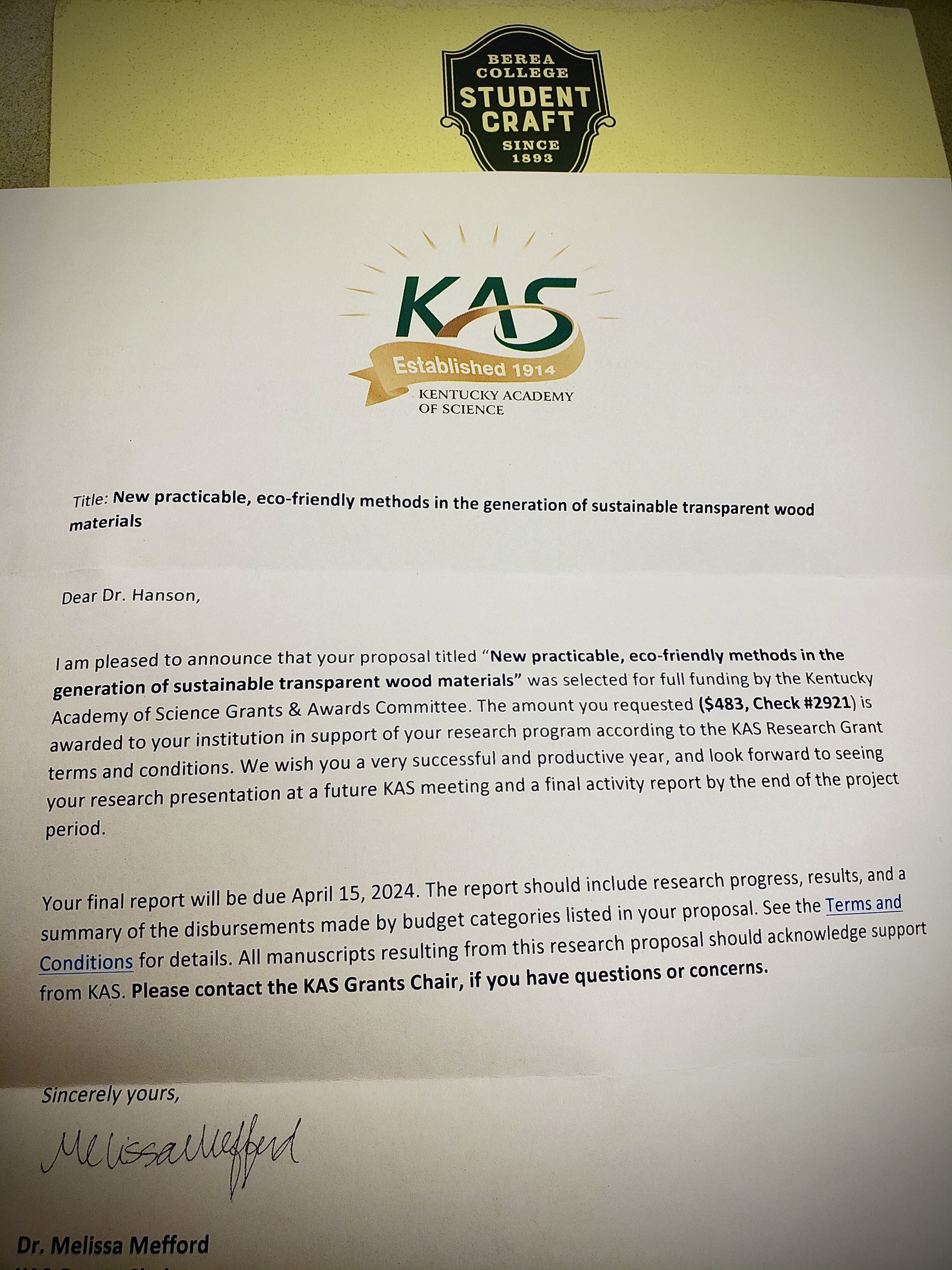My First Grant Rewards for Materials Science
The purpose of grant writing is to secure funding from organizations, government agencies, and private foundations to support a particular project or initiative. Hence, grant writing in science is critical to support scientific research that aims to advance the mission of the funders and the pool of knowledge within a particular field.
Earlier in the academic year, I had developed some ideas for translating the fabrication process of transparent wood materials for the purpose of student craft and woodcraft, but I did not have the instruments and supplies to readily begin my experiments (see prior funding blogpost). I needed funding. I did some prior web searching and asked my academic mentors for advice.
For an undergraduate research project, I applied to Experiment (an scientific crowdfunding resource) and the Kentucky Academy of Science (KAS) Supply Grant (a undergraduate research grant).
After identifying two potential grant sources, I questioned, “what makes a successful grant proposal for these two organizations?” It is important to note that no two organizations are the same. Hence, applying to two or more funding sources requires sufficient understanding of the granters’ mission, reporting timeline, priorities and objectives. Furthermore, all research grants should clearly articulate the significance of the research, the use of the requested funds, and the potential impact of the findings.
Note: sometimes, for more professional funding proposals (such as those under National Institutes of Health, National Science Foundation, etc.), preliminary results must be reported expressing the promise of the project.
When I drafted my proposal, I had multiple outlines and lists of objectives that needed to be addressed in my writing. This helped tremendously!Additionally, I have found that scientific communication is fundamental for not only the grant writing process but for a successful scientific career in general. I earned most of my insight in science writing and communication from my first internship with the Aspirnaut program (read more here).
The most difficult part of writing the proposal, for me at least, was speculating a rough timeline for my research milestones. When will you begin? What do you expect to accomplish by this date? When do you expect to conclude the research? When will the results be published or presented, if at all? Fortunately, I was able to generate a doable timetable.
Once I submitted my proposals, I continued to conduct initial experiments to advance my project. I submitted my KAS Grant Supply proposal on Nov. 15 and launched my Experiment funding campaign on Dec. 5. I requested $483 and $1,735 from the two grant foundations, respectively. Then, I waited anxiously.
Receiving Grant Rewards!
Experiment
After returning from winter break, I had began my second semester of sophomore year. I was anticipating my crowdfunding campaign to conclude very soon. Though, at the time, I was about $600 short of meeting my campaign goal and I was really worried.
Then, I received a message from an Experiment founder, stating:
“Hey Oscar, one of our science angels—Keolu Fox—wants to add $1k to your campaign…. It’s a great project. We’re all very supportive and excited about it here.” - David Lang, Executive Director at Experiment [Profile]
I was very elated. I did not know Keolu Fox, PhD [UCSD Profile], but after I learned about his career and multidisciplinary impact in the field of genomics at UC San Diego, I felt jubilant. Knowing that I wrote a proposal that effectively communicated to a distinguished scientist about my project and research objectives, which he backed, was very encouraging for me as a young scientist.
By the conclusion of my funding campaign, I had raised a total of $2,823 (162% the requested backing) for my project. A huge thanks to all my backers for supporting my project! They are honorably mentioned on my campaign page.
Additionally, what I did not know before launching my campaign with Experiment, is that successfully funded projects receive their very own Digital Object Identifier (DOI), meaning my research can be shared and cited amongst the world of science!
Reference (APA 7th):
Hanson, O. F. (2023). New practicable, eco-friendly methods in the generation of sustainable transparent wood materials. Experiment. DOI: 10.18258/303322
I was very excited with what I was able to accomplish with my first written proposal for a broad scientific audience.
KAS Supply Grant
Moreover, as mid-February approached, I received an email from the KAS grant committee stating that my KAS Supply Grant was selected as one of two undergraduate projects in the state of Kentucky to be awarded supply funds.
Read more under Announcing: 2023 KAS Grant Winners of the March 2023 KAS Newsletter.
The grant committee sent a letter to my labor supervisor, who I selected to be the faculty sponsor of the project. The proposal, titled New practicable, eco-friendly methods in the generation of sustainable transparent wood materials, received full funding. The letter can be viewed below:

Note: The letter addresses me as “Dr. Hanson.” This must be automated because I do not hold such title as of the time of this blogpost.
Altogether, I felt accomplished knowing that I was capable of writing two proposals to a scientific community and grant committee composed of experts who understood the value of my research and financially backed it.
Ultimately, this has been a great experience and I feel incredibly fortunate to have been financially supported by my backers!
Lastly, feel free to ask questions in the comments below or begin a discussion in the forums.